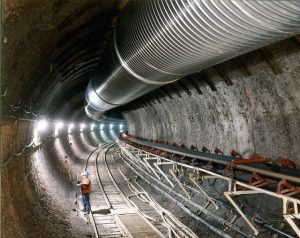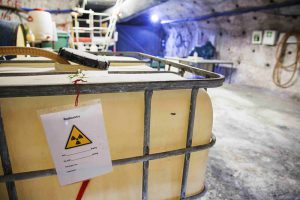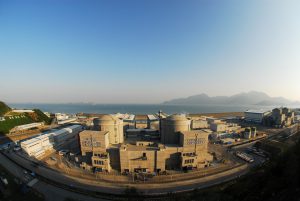China has one the most ambitious nuclear programmes in the world. Over the next five years, it plans to build 40 nuclear power plants at a time when most western countries are winding down their nuclear programmes. The strategy involves building commercial reprocessing facilities to store and process hazardous waste, a by-product of nuclear energy.
Recent plans to build a reprocessing plant in Lianyungang, in Jiangsu province, were stalled after thousands of locals took to the streets in opposition to the proposed Sino-French facility, prompted by environmental and health concerns. The delay offers an opportunity to pause and asses the experiences of other nations that have pursued a reprocessing strategy.
The United Kingdom’s experience suggests that reprocessing is dangerous, not as green as proponents claim and economically unsound. The history of the UK’s longstanding commercial reprocessing activities offers a cautionary tale regarding the pitfalls, which will impact British national policy for decades to come.
The UK experience
Reprocessing remains, in the words of British scientist Brian Wynne, “the most controversial global aspect, of the most iconically controversial of modern technologies”.
Its controversy lies in the fact that reprocessing can be used for the purposes of nuclear weapons proliferation.
Reprocessing was initially developed in the UK in the 1940s and 50s to make nuclear warheads using recovered plutonium and uranium. Later, it was marketed as a “great hope” with untold economic benefits. Its proponents claimed a new type of nuclear reactor, the Fast Breeder Reactor (FBR) could take spent nuclear fuel and recycle it to produce more power. However an FBR programme never materialised on a commercial scale. Following a series of economic and technical problems, the UK abandoned its fast breeder reactor programme in the 1990s.
Sellafield and Magnox
Since 1954, the UK has undertaken reprocessing activities at the site now known as Sellafield in Cumbria. The facility currently operates two reprocessing facilities, the soon-to-be-closed “Magnox” plant and the Thermal Oxide Reprocessing Plant (THORP).
Both facilities have been shrouded in controversy: Magnox only achieved around half of its projected output, according to the Nuclear Decommissioning Authority’s (NDA) 2005 projections; while THORP has been closed for around six years of its 22 years in operation. During its lifetime ,THORP has consistently failed to meet its throughput targets and in 2005, had a major leak of high level radioactive material.
Undetected for several months, this accident led to the closure of THORP for three years, until 2008, at an estimated cost of £2 million (17.8 million yuan) a day. Sellafield was only fined £500,000 for breach of various licensing conditions.
The Mixed-Oxide (MOX) production plant, which also formed a key part of the rationale of reprocessing — the facility was designed to utilise the separated plutonium in the production of MOX fuel for use in conventional reactors — closed in 2011 after 10 years of operation, accumulating a net loss of £2.2 billion. An internal governmental review concluded that the facility was “not fit for purpose”.
When THORP was first debated in the late 1970s, the main justification was that it made commercial sense. Reprocessing, proponents said, turned spent nuclear fuel from a “waste” product into an “asset”, because the separated plutonium could be used in the much-vaunted FBRs. An echo of the arguments you hear in favour of reprocessing today.
But despite repeated claims around FBRs, no fast breeder reactor programme exists and there is no commercial fast reactor operating anywhere in the world.
It is perhaps unsurprising then, that Wynne concluded UK reprocessing represents “one of the UK’s great public technology policy disasters”. Beyond the safety implications highlighted by the leak in 2005, as well as a recent BBC documentary that revealed acute problems with the storage and protection of plutonium and other fissile materials, immense costs and operational set-backs that characterise the history of reprocessing in the UK.
Doubts over fast breeder reactors
China’s commitment to reprocessing is underpinned by plans to develop FBRs on a commercial scale over the next 20 years. In the 1970s, FBR supporters in the UK claimed they would make a significant contribution to the UK’s electricity generation – a contribution that never materialised. The same could happen in China.
As a consequence of its failed FBR programme, the UK has accumulated the largest stockpile of plutonium in the world, which costs an estimated £80 million a year to store securely and safely. With no solution to this plutonium storage problem, it will most likely have to be secured for decades to come at a cost of hundreds billions of pounds, and potentially great danger to the public and environment. Spent nuclear fuel in China is currently stored at reactor sites in ponds and a centralised storage facility has also been built at the Lanzhou Nuclear Fuel Complex. China is also exploring sites for Deep Geological Disposal. Given the scale of China’s nuclear new build programme, a sizeable, expensive and potentially dangerous plutonium legacy could also present itself in China.
But what if the long-promised potential of fast breeder reactors is realised? In the 1970s, many experts viewed fast breeders as the future; an essential technology, as other finite energy sources were set to decline and the price of uranium set to rise. Today, the development of fast breeders is justified due to their “low carbon” status, with some environmentalists enthusiastically supporting fast breeder technologies – including in China.
Yet it is long understood that pursuing FBRs means creating a “plutonium economy”, which due to the security risks involves high levels of secrecy, armed protection and vetting – as can be seen at Sellafield — which would have had to have been replicated at various sites across the country if FBR technology had been developed. This throws in to question the degree of transparency that can be achieved — and the effects this lack of transparency has on how business is carried out. At THORP, there is a series of worrying examples of malpractice: quality issues, resulting in Japan refusing to use the fuel and BNFL paying £40 million in compensation; an economic report used by politicians to justify THORP that turned out to not actually exist; a major leak remained undetected for nine months; frequent concerns around transportations of plutonium; and the Sellafield facility in 2006 breaching EURATOM’s safeguards policy to ensure that fissile materials are not diverted from the peaceful uses for which they have been declared.
Over the years, THORP has been condemned by politicians, business leaders and environmental groups alike, who referred to the management culture around UK reprocessing as having a “disdain for the government and the public”. And this seems to be the experience internationally, not just in the UK.
In the context of the energy transition in China, committing to FBRs is likely to stand in the way of greater transparency and participation in decision making. Whether or not it is worth the risk, the UK government will be dealing with the consequences of reprocessing for decades to come.







